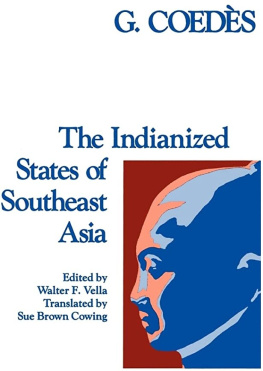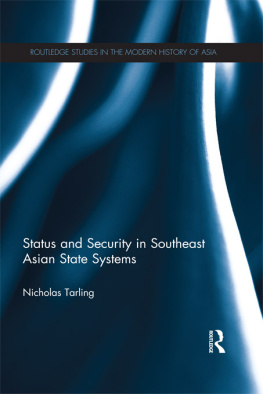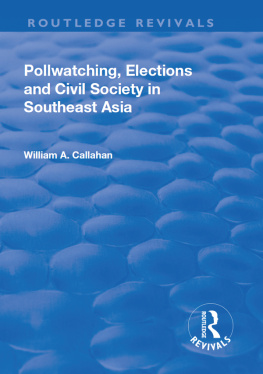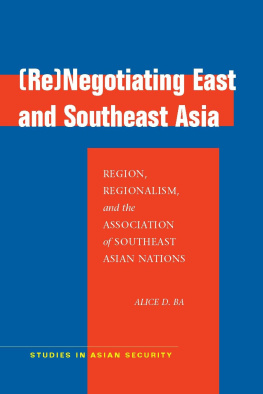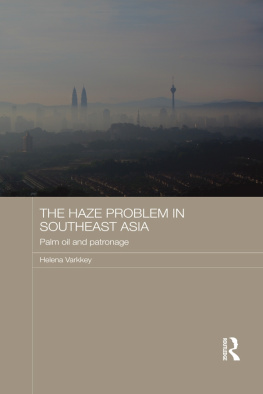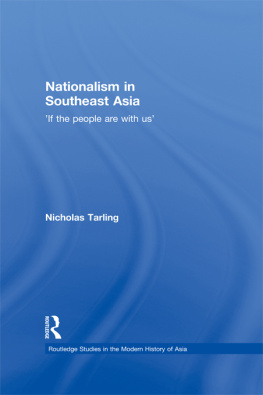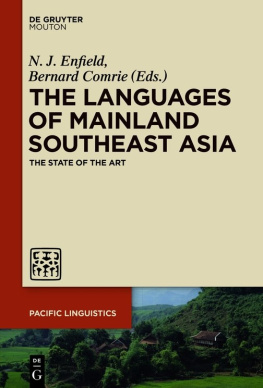The Indianized States of Southeast Asia
by
George Cds
Edited by Walter F. Vella
Translated by Susan Brown Cowing
East-West Center Press
French edition 1964 by ditions E. de Boccard, Paris
English edition 1968 by East-West Center Press
(since July 1977, The University Press of Hawaii)
Contents
Illustrations
Note on Second Edition
A first edition of this work appeared in Hanoi ( Imprimerie dExtrme-Orient ) in 1944, under the title Histoire ancienne des tats hindouiss dExtrme-Orient. It was soon out of print in Indochina.
Insofar as possible, this second edition takes into account the relatively few works that were published during the time Indochina found herself isolated and deprived of relations with Europe and America. Many pages dealing with Funan, pre-Angkorian Cambodia, and early Champa have been rewritten in order to take into account the recent Sinological and epigraphical studies, still unedited, that will be published in the Bulletin de lcole Franaise dExtrme-Orient or elsewhere.
Paris, November 1947
Note on Third Edition
The second edition having in turn gone out of print in 1962, a third edition has become necessary. I have taken advantage of this opportunity to bring up to date a work that was greatly in need of it. Since the end of the war, numerous studies devoted to Southeast Asia have greatly advanced our knowledge of its past. I was thus obliged to enlarge the bibliographic references and, above all, to rewrite completely a number of sections that, as originally written, no longer reflected the present state of research. I hope that, in fifteen years or so, this third edition will in its turn be made obsolete by the progress made by an increasing number of scholars attracted to the study of the Indianized states, whose history I believe I was the first to synthesize.
Paris, November 1963
Editors Note
It would be difficult to overestimate the contribution of George Cds to the field of Southeast Asian studies. He is revered by other scholars in the field as the unchallenged dean of Southeast Asian classical scholarship. Since 1904 a truly prodigious and uninterrupted flow of articles, books, and papers on various aspects of early Southeast Asian history has issued from his pen: he has discovered and translated primary materials (inscriptions and annals in Pali, Sanskrit, Cambodian, Thai); he has interpreted the meaning of these materials in approximately two hundred scholarly articles; and he has synthesized his own work and that of his colleagues by writing integrated, readable accounts for specialists and the general public. Any one of his many epochal discoveries would be regarded as the proudest achievement of many a scholar.
Cds primary interest has been in the history of the Khmer Empire. His contribution here has been to supply a reliable historical chronology and an incisive delineation of the nature of Khmer kingship and other traditional Khmer institutions. What we know of ancient Cambodia stems predominantly from the work of Cds. In other areas of Southeast Asia, Cds is most famous for his pioneer depiction of the origin of Sukhothai, the first historical kingdom of Thailand, and his dramatic identification, in 1918, of the name, geographical scope, and importance of the ancient Indonesian empire of rvijaya. His discovery of rvijaya has been called, by Paul Wheatley, possibly the most significant contribution ever made to the progress of Southeast Asian history.
Cds major work of synthesis is his study Les tats hindouiss dIndochine et dIndonsie, here translated, that covers the period from approximately A.D. 1 to A.D. 1500. This work has been universally acclaimed andthe surest proof of its impactheavily relied on by all later scholars. Revised by Cds in 1964, it is the basic text for all those who seek to understand Southeast Asianot only its ancient past but also its immediate presentfor the Southeast Asia of today cannot be understood without a knowledge of the traditional values and institutions, which remain vital and which present leaders seem increasingly to esteem as a guide to the future.
A few notes on editorial policy may be in order for those who wish to compare the translation with the French original. The aim throughout has been to adhere scrupulously to the meaning of the original text. The format of Cds footnotes has been modified: full citations of sources have been provided for first references in each chapter; titles frequently referred to have been abbreviated, and a key to all abbreviations has been supplied. All quotations from English sources have been searched and supplied as they appear in the original quoted material. A few minor editorial changes have been made for the sake of clarity. Finally, the entire English text has been submitted to Professor Cds, and approved by him.
A note on the system of transliteration used: An attempt has been made to adhere to the spirit of Cds transcription of Indian, Chinese, and Southeast Asian words and namesthat is, to use as simplified a system as possible consistent with good usage. Many common geographic and other terms (e.g., Mekong, Vishnu, Mahayana) have been given in the spellings that appear in standard dictionaries. Tonal marks are not indicated for Chinese, Vietnamese, Burmese, or Thai. For most words and names the following systems were used as guides: for Chinese, the Wade-Giles system; for Vietnamese, the standard quc-ng; for Thai, the system recommended by the Royal Institute of Thailand in 1941; for Sanskrit and Pali, the system used by most Indologists.
Walter F. Vella
Honolulu, Hawaii
July 12,1967
Introduction
The present volume complements the one which Louis de La Valle-Poussin contributed to the Histoire du monde series in 1935 under the title Dynasties et histoire de lInde depuis Kanishka jusquaux invasions musulmanes (Vol. VI, Part 2). The present work is announced there (p. 296) and is to some extent anticipated there by substantial notes and bibliographic references (Appendix 2: Navigation et colonisation, pp. 29197). Perhaps I should have followed the same method as La Valle-Poussin , offering readers a simple outline accompanied by critical notes and, when possible, glimpses of the whole. The historical study of Southeast Asia is even less advanced than that of India, and it might seem premature to attempt to produce an unbroken and coherent narrative from incomplete information. I have, nevertheless, tried to do this, for my purpose is less to produce a history presenting all the details than to offer a synthesis showing how the various elements of the history are related.
The geographic area here called Farther India consists of Indonesia, or island Southeast Asia except for the Philippines; and the Indochinese Peninsula, or India beyond the Ganges, including the Malay Peninsula. Excluded are Assam, which is simply an extension of India and Bengal, and northern Vietnam, whose history developed outside Indian influence.
The natural riches and geographic position of the region thus defined confer on it a place of primary importance. Around the beginning of the Christian Era, Southeast Asia was the land of gold toward which the Indian navigators sailed; a few centuries later, it (especially Indonesia) became the land of spices, camphor, and aromatic woods for the Arabs and Europeans; more recently, the region has become one of the most important producers of rubber, tin, and oil. Moreover, the position of the Malay Peninsula and of the Sunda Islands makes them a necessary port of call for seamen going from the West or India to China and vice versahence their importance in maritime commerce.
Culturally speaking, Farther India today is characterized by more or less deep traces of the Indianization that occurred long ago: the importance of the Sanskrit element in the vocabulary of the languages spoken there; the Indian origin of the alphabets with which those languages have been or still are written; the influence of Indian law and administrative organization; the persistence of certain Brahmanic traditions in the countries converted to Islam as well as those converted to Singhalese Buddhism; and the presence of ancient monuments which, in architecture and sculpture, are associated with the arts of India and bear inscriptions in Sanskrit.
Next page
